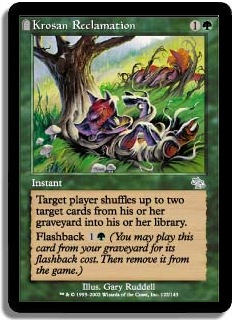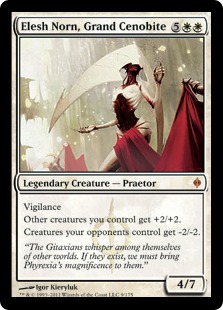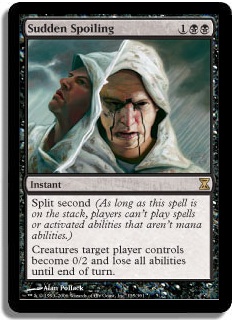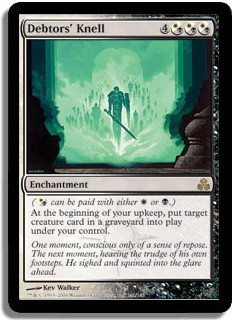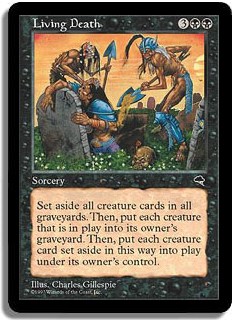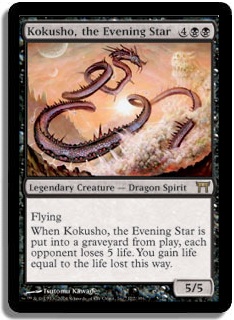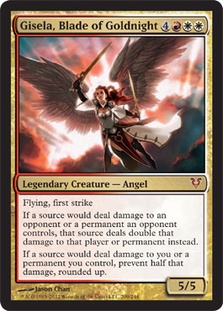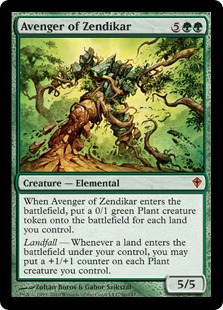The comments on last week’s article asked for a full decklist for Karador, Ghost Chieftain, and since it’s undergone some radical changes since I last listed it, I thought it might be a good idea to list it again. I won’t be going through a card-by-card breakdown, but I am going to go into some of the strategies that I use during play and talk about some of the card combinations that I think are the deck’s strengths. I don’t think I’ve done too much strategic discussion on decks, so this will be something a little new.
We’ll also talk about how the Armada Games EDH League Kokusho testing is going, with a quick update for League 15, Week 2. First, the decklist:
Creatures (43)
- 1 Sakura-Tribe Elder
- 1 Solemn Simulacrum
- 1 Kokusho, the Evening Star
- 1 Wood Elves
- 1 Hermit Druid
- 1 Eternal Witness
- 1 Bone Shredder
- 1 Yavimaya Elder
- 1 Duplicant
- 1 Wall of Roots
- 1 Karmic Guide
- 1 Netherborn Phalanx
- 1 Angel of Despair
- 1 Ghost Council of Orzhova
- 1 Saffi Eriksdotter
- 1 Stonecloaker
- 1 Riftsweeper
- 1 Seht's Tiger
- 1 Reveillark
- 1 Woodfall Primus
- 1 Archon of Justice
- 1 Deathbringer Liege
- 1 Divinity of Pride
- 1 Doomgape
- 1 Elvish Visionary
- 1 Wall of Reverence
- 1 Dauntless Escort
- 1 Acidic Slime
- 1 Avenger of Zendikar
- 1 Terastodon
- 1 Wall of Omens
- 1 Primeval Titan
- 1 Sun Titan
- 1 Wurmcoil Engine
- 1 Massacre Wurm
- 1 Elesh Norn, Grand Cenobite
- 1 Sheoldred, Whispering One
- 1 Karador, Ghost Chieftain
- 1 Vish Kal, Blood Arbiter
- 1 Devouring Swarm
- 1 Silverchase Fox
- 1 Restoration Angel
- 1 Harvester of Souls
Lands (37)
- 5 Forest
- 7 Plains
- 1 Wasteland
- 1 Volrath's Stronghold
- 4 Swamp
- 1 Scrubland
- 1 Savannah
- 1 Bayou
- 1 Windswept Heath
- 1 Maze of Ith
- 1 Krosan Verge
- 1 Overgrown Tomb
- 1 Temple Garden
- 1 Godless Shrine
- 1 Murmuring Bosk
- 1 Sunpetal Grove
- 1 Marsh Flats
- 1 Verdant Catacombs
- 1 Bojuka Bog
- 1 Command Tower
- 1 Isolated Chapel
- 1 Woodland Cemetery
- 1 Vault of the Archangel
- 1 Grim Backwoods
Spells (20)

This may be as close to a control deck as I ever play in that it seeks to keep other players in check by having copious and recursive answers to their threats. Nine of the 42 creatures can in one fashion or another directly take out a permanent (Duplicant, Acidic Slime, Archon of Justice, Bone Shredder, Deathbringer Liege, Massacre Wurm, Silverchase Fox, Terastodon, Elesh Norn—although I suppose you could easily consider Sheoldred a tenth).
Using the graveyard as an additional library makes it possible to use them again. Then there are the board control elements like Black Sun’s Zenith, Profane Command, Wrath of God, and to some extent Crime / Punishment; although if I really wanted to be efficient, I think replacing that with Pernicious Deed is probably a good idea.
So How Does the Deck Win?
“Slowly” is the first answer. The deck wants to keep off the table too many threats and then grind with larger guys like Doomgape, Divinity of Pride, the Swampwalking Sheoldred (lots of folks forget about that part, probably because it gets killed so often), Sun Titan, Kokusho, and Vish Kal. Another part of that answer is the life gain. Vish Kal and Wurmcoil Engine obviously have lifelink, Doomgape will both gain life and put dudes back in the yard for regrowing, but my experience is that Wall of Reverence is the most significant of the life gainers (unless you’re attacking with a swarm and activate Vault of the Archangel). I haven’t had the opportunity yet to use Kokusho too much but that also becomes significant in both the life gain and slow grind aspects; since there aren’t any infinite recursion engines I think it’s more a piece of the greater puzzle as opposed to a path in and of itself. I suppose left unchecked with Karador out it could go pretty quickly.
The second answer is “epically.” There’s the (confessedly overused) Avenger of Zendikar swarm, but in this case I’m actually talking about blowing out someone with Massacre Wurm or Netherborn Phalanx. Obviously, you can’t do this without them having huge pile of guys. I actually think that folks too often hold on to Massacre Wurm, hoping to squeeze out something optimal instead of doing a little something now and more of something later. I hold it as viable to get it onto the battlefield then get those bits of life loss ticked off two at a time.
What Are the Deck’s Weaknesses?
The deck mostly rolls over to graveyard hate, although inclusion of Riftsweeper and Krosan Reclamation help a great deal. When playing, I try to be extremely careful about filling up the graveyard too much. I like to put some stuff in the yard and then play around with it. You’ll notice no Entomb or Buried Alive. It’s more fun to just play with what I get. The reason there are sixteen basic lands is so that Hermit Druid doesn’t hang me too far out there. I really use it for the synergy of getting land and putting stuff in the graveyard, not to combo off. There are times when it just dumps too much in there and I feel like I’m walking a tightrope the entire game, as it did in the League game I’ll talk about later. First two times I activated it, it was one card, one land. The third time, it slipped 30 cards into the yard, and I knew one Bojuka Bog would wreck me.
The deck can deal with all permanent types, so there’s no permanent in particular that I’m too concerned with; although if Grafdigger’s Cage is in play and all the artifact removal is in the graveyard, that could be a problem.
I’d also say that the ramp is a little light. The tech is more to draw cards (early with Elvish Visionary, Wall of Blossoms, and Wall of Omens, later with Greater Good) and get lands in those draws. The deck is a little mana-hungry because it wants to be active, always casting stuff, but doesn’t ever really have the giant piles of lands. That might be an argument for Cabal Coffers.
One of the weaknesses is that other than a big Avenger of Zendikar, there’s no big punch, deal-with-me-now-or-die creature, although Kokusho may be able to fill that role in the short term. Again, it’s more of a grinding, defensive, midrange game than an offensive one, so one of the downsides is the difficulty in keeping up with really aggressive decks like Rhys the Redeemed or Rith, the Awakener. Decree of Pain might be a viable Profane Command replacement because it adds another sweeper (with two different methods of sweeping) and avoids the all-in graveyard strategy.
The only methods of getting back non-creatures are the two Regrowth cards (Regrowth and Eternal Witness) and shuffling them back into the library with Krosan Reclamation—although I’ve repeatedly found the Reclamation more useful at stopping others from doing nasty graveyard recursion things quite a bit more often than I’m shuffling back in my own stuff.
While the deck isn’t 100% dependent on Karador, it’s a significant part of the strategy. The good news is that it’s usually pretty cheap; almost always still three to recast even for the fourth or fifth time. The bad news is that it’s both expensive and kind of useless after you get Bojuka Bogged. There have been a few times I’ve found that Karador can get killed and I can keep in the game with some of the synergies listed below, but they’ve been rare.
I don’t know if it’s actually a “weakness,” but I’ve found Restoration Angel to be a bit of a nonbo with the creatures I’d most like to Blink:Â Angel of Despair and Karmic Guide. Fortunately, it’s still pretty useful with some of the other guys in the deck.
Favorite Synergies/Combos
Everyone knows (and I’m pretty sure lots of people are tired of, and not just from me) Reveillark (add a Saffi activation for more hijinks) for Eternal Witness and Karmic Guide into Sun Titan, etc. It’s trite, but it’s strong and useful. Too bad Phyrexian Delver’s power is three. There are other good synergies built into the deck.
Restoration Angel / Massacre Wurm:Â I mentioned earlier that some folks wait to play Massacre Wurm. With Restoration Angel back up, you can play it early then catch people off guard when they think they’re safe. Post-Massacre Wurm Elesh Norn has basically the same effect.
Elesh Norn, Grand Cenobite / Sudden Spoiling:Â Elesh Norn is certainly simply good on her own, but add the nearly uncounterable Sudden Spoiling to the mix and you have a one-sided board wipe.
Saffi Eriksdotter / Karmic Guide:Â Put Karmic Guide’s echo trigger on the stack, then sacrifice Saffi targeting Karmic Guide. Worst-case scenario is getting back Saffi. If Sun Titan is in the yard, get it back to get back Saffi.
Stonecloaker / Reveillark: The ‘lark doesn’t have to go to the graveyard to trigger—it’s a leaves play ability, so using it with Reveillark gets you two effects for one. The nice thing about Stonecloaker is that it’s hidden graveyard removal, so unless they know you have it they can’t exactly play around it.
Restoration Angel / Seht’s Tiger:Â The Tiger seems like another one-and-done until Restoration Angel comes along, treating you to another Fog. I’ve mentioned before that Fog effects are vastly underrated, but I think they’re part of your necessary survival kit in the format. If you have the mana in a desperate situation where you’re attacked with creatures of multiple colors (let’s face it, most of the time Seht’s Tiger is protecting you from green), you can flash it in, name a color, Blink it with the Angel, and name the other.
Netherborn Phalanx / Transmute: Phalanx can fetch Duplicant, Wurmcoil Engine, Harvester of Souls, Massacre Wurm, Sun Titan, Primeval Titan, and Kokusho, meaning exactly the utility you need when you need it—then, of course, being in the graveyard for a nice reuse.
Ghost Council / Board Wipes:Â Whether they’re yours or someone else’s, board wipes need to happen. If you’re going to lose your guys anyway, having Ghost Council come back afterward always gives you a leg up.
Lines of Play
Trying to get regular and repeatable results out of a singleton deck that doesn’t have a pile of Tutors is challenging at best. Nonetheless, the general idea is the same:Â mount some defense early on while developing your mana/keeping your hand full. There’s no need to rush filling up the graveyard. It’s likely that other creatures in play with be slightly better than yours. You can chump block because the cheap creatures have already done their work, whether it’s drawing a card like Elvish Visionary and Wall of Omens or ramping you like Solemn Simulacrum or Wood Elves. Once your utility guys are in the yard, you might Wrath to equalize or be able to cast Karador and start the process all over again, quickly getting to the mana you need for your larger guys not to mention the larger guys themselves. At that point, your play line depends on your opponents’ threats and threat density and what you have in the yard. Your tendency is going to be to reuse whichever good thing is at your fingertips.

There are two cards which when drawn early will point your line of play in particular directions:Â Birthing Pod and Hermit Druid. Pod is clearly about the chain:Â Wall of Omens into Wood Elves (or Yavimaya Elder) into Solemn Simulacrum into the then-branching choice of Acidic Slime or Reveillark, dependent on your needs. If you don’t need the Slime, Reveillark is the choice since you can get back any of the previous cards when you sacrifice it for that six-drop, which is likely going to be board-dependent. If nothing is pressing, Primeval Titan is probably the call. Given the amount of life gain in the deck, I never worry about paying the Phyrexian mana for either casting Birthing Pod or activating it. At a certain point it’s easy to just pay the green, but especially in turns 4 and 5 you’ll probably want that mana to do other stuff with as well.
Hermit Druid sends you in a different direction entirely; one that hopefully leads quickly to Karador and then regrowing good stuff. With sixteen basic lands in the deck you’re not often going to go 15-20 cards deep, but it’ll happen, as I mentioned above. I have noticed having to be quite careful about using the Druid later on by always keeping count of the basic lands left in the deck versus the number of cards. As we discussed earlier, the deck generally wants to grind a long game, so you’re not going to do yourself any favors by drawing yourself out or by making your Greater Good useless. Using GG as sacrifice outlet, meaning the card draw notwithstanding, has three basic functions:Â saving your stuff from getting stolen, getting creatures into the graveyard so that you can reuse them, and sacrificing Woodfall Primus in order to persist it back and get its trigger again. You don’t want to get into a situation where you don’t have those options available to you because you’re worried about decking yourself.
Speaking of persist, the only reason Puppeteer Clique isn’t in the deck is that it’s in a number of other decks already. I’m pretty sure that I’m going to make room for it somehow.
Other Cards Considered or Worth Considering
Debtors’ Knell: When it stays around a long time, it can be awesome—but people rightly fear it so much that it’s often a seven-mana “skip your turn.”
Feed the Pack:Â I’ve had it in and out of the deck. The synergy with multiple cards is apparent and getting stuff into the yard is the right choice. In the end, it suffered from needing to get cut for the Greater Good since I felt as though the card draw was too weak.
Harmonic Sliver:Â Can be coupled with Necrotic Sliver below. The downside is the ability isn’t a may. If you resolve it, you have to blow up something.
Hex Parasite:Â A card that I’ve also had in and out; it’d be cute to reset Wall of Roots, get the persist counter off of Woodfall Primus, and kill some planeswalkers, but in the end it suffered from “too many good cards to run, not enough slots to run them in.”
Living Death:Â Certainly worth considering, but without good control of other graveyards, like with Scavenging Ooze or Withered Wretch, a little dangerous.
Necrotic Sliver:Â A slightly cheaper Angel of Despair that doesn’t really attack but is recursive Vindicate.
Puppeteer Clique:Â This is the one that’s going to need serious consideration since it’s playing with your graveyards and not mine.
Scavenging Ooze and Withered Wretch:Â You can’t do everything and just have a deck full of utility creatures, meaning something had to go. Stonecloaker (and as I discovered Krosan Reclamation) fit the graveyard hate role, although I’ll concede to missing especially the Wretch.
Obviously, if you think there’s something that’s just too good to not be in there, let me know.
League Report/Kokusho Testing
I had the opportunity to play six (actually seven) games over the course of the day, including two League games.
Game 1:Â Playing Mimeoplasm, with Mark (Vela), Guy whose name I didn’t get (Wort the Raidmother), and Apple (Rubinia Soulsinger)
Vela played Tormod’s Crypt turn 1, which put quite a damper on all Mimeoplasm strategies, not just Kokusho. On turn 6 I had both KK and Primeval Titan in my hand, and the play was clearly Prime Time so that I could get Grim Backwoods for future sacrificing. The board was getting nasty with Goblins, so I cast Damnation knowing I had Kokusho and a sac outlet. I cast her and then was forced to Backwoods it right away when Rubinia tried to steal. I knew I was playing with Riftsweeper, so the Crypt didn’t really bug me too much.
The Wort player then played Scrambleverse, which fortunately (more for the annoyance factor) got countered. The Wort player then scooped up his cards saying that he had to leave anyway. Here’s a tip boys and girls: playing Scrambleverse then scooping is not a way to win friends. That guy is on my “no cake” list. Actually, I don’t have a “no cake” list, but I’m creating one just for him.
The game went pretty long afterward with a number of back and forths; Vela’s ability slowly ate away at our life totals. KK stayed in the graveyard a while; Mark didn’t care to use the Crypt since I hadn’t tried anything funny. I finally Regrew her, but Mark for some reason thought that Rubinia’s graveyard was tastier than mine. By the time I recast her Apple was at five life, so without some real miracle he was toast. Extractor Demon made short work of Mark’s library, and I eventually ultimated Jace, Memory Adept to mill him out. I had Rite of Replication in my hand, so I could have also attempted to kill him with targeting KK. When I asked, he said he didn’t have an answer to that either.
Conclusion: I didn’t play differently on T6 than I would have otherwise, but one of the lands I fetched was different (getting the Backwoods instead of a colored mana producer). KK had an effect on the game in that it killed one player, but he was at five anyway—flying over and attacking would have done the same.
Game 2:Â Playing Thrax with Kyle (Treva, the Renewer), Apple (Rubinia), and Mark (Gisela, Blade of Goldnight)
Kokusho never made an appearance, and the game reached an anticlimactic finish when Kyle resolved Test of Endurance while at 70+ life and none of us had answers. My turn was the last one before he won. He was at 68, and I had Slave of Bolas and Backlash in my hand. Had Mark been able to recast his Gisela (he was one mana short), I could have Backlashed Kyle’s Celestial Force then taken it with Slave of Bolas, dealing a total of 28. Unfortunately, it wasn’t to be.
Game 3:Â Playing Animar with same three players and decks
There was no black, so there was no KK. Some stuff happened, and eventually Gisela killed us all.
Game 4:Â Playing Intet, the Dreamer with Mark (Gisela), Chris (Skullbriar), and Kyle (Baru)
Chris was the only person playing black, and he was not playing The Evening Star. Chris was the obvious early starter, which drew some retribution. Kyle then got in the act since his guys were getting trample every turn, and Mark was careful about playing Gisela knowing that it was dangerous for me and Chris and he was having trouble keeping Kyle in check by himself. I actually didn’t do much during the game. We eventually scooped up because League started, but I’m pretty sure Kyle would have done in the three of us.
Game 5 (League Round 1):Â Playing Kresh with Chris (Thraximundar), Keith (Avacyn, Angel of Hope), and GeFe (Rhys the Redeemed).
GeFe ran out Keeper of Progenitus, and you can see the direction it’s going. Quite honestly, without it I would have never been in the game at all, but it just multiplies my disadvantage especially since it’s just a Mana Flare for Keith, who powered out Avacyn on turn 4. To prove that there was no collusion, he battled GeFe twice. I did get to cast Mikaeus and then Kokusho the next turn. It looked like things were turning south for the table when GeFe put on the serious pressure by casting Genesis Wave for nine, getting Cathar’s Crusade, Doubling Season, Privileged Position, Concordant Crossroads, and most importantly, Platinum Angel.
He couldn’t make any guys that turn (phew!), but we knew his next one was going to be crazy. Chris upped the ante by casting Rite of Replication kicked on Kokusho, sending GeFe into negative territory. Mikaeus brought back Kokusho for me, but it was never a factor. The following turn, GeFe made a bunch of huge guys and swung. Fortunately I had Tangle in hand, so we lived to fight another turn. Chris drew no answers, I drew no answers, Keith drew no answers, but I also had Spore Cloud in hand so we were OK. And then GeFe said, “Wait, I had Dosan the Falling Leaf in play last turn!” We look and there it was, hidden beneath the piles of tokens and dice. We all facepalm. He then made more dudes and killed us. I was one short of being able to make enough dudes with Night Soil and block all his guys. It wasn’t a question of mana—there just weren’t enough creatures in graveyards.
Total game time was less than 30 minutes, so we turned in the sheet and played another one. It went much longer, but Kokusho never made an appearance. Somewhere after turn 10 or 11, Chris and I both Praetor’s Grasped each other and got the same card:Â Living Death. He cast his first as kind of an emergency Wrath due to Keith’s flight of Angels (including Avacyn), but I had Disciple of Griselbrand on the battlefield so I recovered all my dudes (including Urabrask). When they came back, I also had enough to remove everyone’s creatures from their graveyards with Scavenging Ooze. I cast Chris’ Living Death and killed the table.
Game 6 (League Round 2):Â Playing Karador with Shea (Phelddagrif), Todd (my Intet), and Apple (Merieke Ri Berit). Shea’s deck is new, and it’s not-hugs Phelddagrif with Walls. Todd decided he wanted a break from playing his Rith deck and asked to borrow my Intet because he “wanted his brain to hurt.”
We played a super long, super crazy game which eventually devolved into a 3-on-1; the Intet deck just completely dominated via Seedborn Muse, Consecrated Sphinx, and Alchemist’s Refuge but was not quite able to finish off anyone. In fact, we played the full two hours without anyone being eliminated. We turned in the sheet and agreed to continue playing since we were having a pretty good time.
Epic moment #1 was Shea playing Cavern of Souls naming “Wall.” Epic moment #2 was me finally having an answer to Todd’s crazy board of Kozilek, Ulamog, Prime Time, Consecrated Sphinx, Murkfiend Liege, and some smaller guys. Todd was down to about fifteen cards in his library and no sac outlets, so I made my move. I cast Elesh Norn, planning on then blowing him out with Sudden Spoiling. Unfortunately for us, he had Desertion in his hand. I said, “That didn’t quite work out the way I wanted it to.” I saved Sudden Spoiling for his attack step so that there was no annihilator. Ulamog got exiled somehow the following turn, but Todd found a way to sacrifice Kozilek so we started the whole thing over again.
Epic moment #3 came a few turns later when Todd cast Avenger of Zendikar with 25 lands in play. “That’s not particularly epic,” you’re no doubt saying to yourself right now, and you’re right. Anyway, this is more of an epic sequence. Apple shrugged and cast Avenger of Zendikar of his own. Todd said, “Might as well,” and cast Snapcaster Mage to flash back Desertion. The table and a few spectators roared. Apple and Shea had nothing for it, so it was up to me. My plan was pretty clear. I cast Black Sun’s Zenith for just enough to kill all the tokens. Todd thought for a minute, shrugged, said something to the effect of me not having too much that can hurt him, and countered BSZ with Spell Crumple. I spent my last six mana to cast Netherborn Phalanx.
If you know Todd, you know he has a huge, infectious, face-splitting grin. This time the smile was accompanied by the big nod of “you got me” and a high five. The rest of the game, in which I got some of my own medicine with Shea milling me out with Jace, Memory Adept and killing Apple with a swarm of White Sun’s Zenith tokens, was almost anticlimactic.
Despite seeing 80% of my deck, I never saw Kokusho. She would have certainly been welcome as my life total dwindled. I once again didn’t hear any reports of her from the other tables, but since my games were pretty intense and the other tables were on the other side of the wall, I may have missed something. League Chairman Michael Fortino will have the reports for me to review next week, when I’m certain more Chaos will be Embraced. It will also be June 20, when the new Banned List announcements are made, so tune in for all the excitement!

